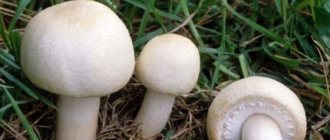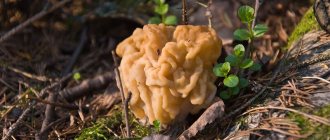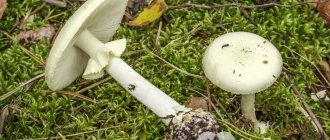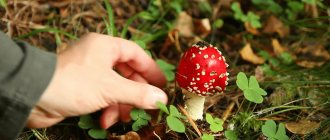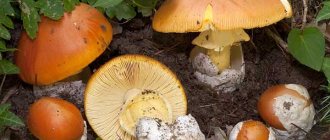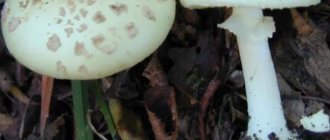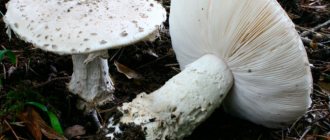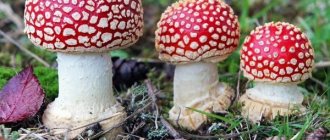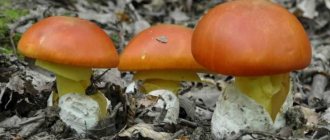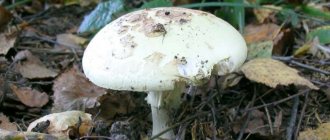What does a pale grebe look like?
The pale grebe looks beautiful, neat and aesthetically pleasing, especially when young.
The cap is dry or slimy, diameter is 6-12 cm, the shape varies from slightly convex to ovoid, which becomes prostrate with age. The color ranges from yellowish-olive to greenish, with dark ingrown fibers. Less common is dark brown, olive or almost white. At a young age, flaky white warts are scattered on the caps of toadstools, which disappear in adult mushrooms. The type of mushroom varies depending on age.
The pulp is thin, white.
The plates are white, free, wide.
The leg is white, yellowish or greenish in color, cylindrical, 10-15 cm in height, but quite thin 1.5-2 cm, with an expanded base.
The volva is wide, cup-shaped, free and does not grow to the volva, as, for example, as in the red fly agaric - it grows to the leg with its edges, but on the contrary, it seems that the leg is inserted into it. Volva is located at the bottom of the leg (near the ground). The color of the outside of the Volvo can be yellowish, greenish or white.
The ring is white, slightly striped on top, and the legs are usually erect at the top. Can be whole or torn.
The spores are almost spherical and smooth. Spore powder is white.
Young specimens have an extremely pleasant, honey-like aroma. In older people, on the contrary, the smell is unpleasant, a little sweet. The taste of pale toadstool is pleasant, without a metallic aftertaste, but you should not try these mushrooms.
Poisonous mushroom toadstool: photo and description of the plant
Pale toadstool, or green fly agaric (Amanita phalloides) is a deadly poisonous mushroom.
The pale grebe acquired ominous fame in ancient times. It is known that Emperor Claudius was poisoned by food prepared from a poisonous mushroom, and the bride of Tsar Ivan the Terrible, Martha, was poisoned. The pale grebe has no analogue in terms of the strength of its poison. 1/2 cap can cause the death of several people. Persistent toxins phalloidin, falloin, amanitin, etc. were found in the pale grebe. The poisons slowly but inevitably affect the internal organs.
Pale toadstool is a poisonous lamellar mushroom with a strong toxic effect. It grows from the end of August until the first autumn frosts, preferring deciduous and broad-leaved forests. Grows under oaks, maples and pines. It is rare, but in some years it produces a large harvest. Pale toadstool is a fairly moisture-loving mushroom and it grows at a time when many edible mushrooms are developing in the forest: russula, white mushrooms, oak mushrooms, boletus mushrooms and many others. During this period, grebes are found not only in deciduous forests. They are also found in pine plantings.
The cap is up to 10-12 cm, convex, then flat-convex, smooth yellow-green, olive-green, darker towards the center, radially fibrous, sometimes with whitish remains of the veil. There is a form with a white cap. The bell-shaped cap of young mushrooms becomes prostrate with age, and in some varieties it becomes depressed. At high air humidity, its shiny, silky-to-touch surface is covered with a thin layer of mucous plaque, sometimes with mealy flakes. The edges of the cap are smooth, even, with hanging remains of the white cover. The plates are wide, frequent, free, white.
Habitat
The green fly agaric is quite thermophilic and prefers mainly deciduous forests. Favorite habitat in Russia is linden and oak groves. It is observed throughout the taiga zone. But still, for the most part, he loves the south, especially the forest-steppe zone, for example, the Volga region, Ukraine.
The pale grebe loves moisture very much, so the forests are simply strewn with them after the rains. It is quite rare in dry areas. They can grow either in groups or alone.
Signs of poisoning by toadstool
The first signs of toadstool poisoning do not appear immediately, after 10–12 hours, and sometimes 30 hours after eating the mushroom and are accompanied by headache, dizziness, disturbance of normal vision and restlessness. The patient feels intense thirst, burning pain in the stomach, and cramps in the limbs. This is followed by cholera-like attacks in the form of bilious vomiting and severe diarrhea. The urine is dark and is excreted in small quantities. Severe pain is felt in the liver, especially when pressed. Profuse sweat appears, extremities become cold, and within a day or two death occurs. In 90% of cases, poisoning with toadstool or toadstool is fatal.
Edibility
The pale grebe is deadly poisonous and is not used as food. Moreover, not only the body of the mushroom is poisonous, but even the mycelium and spores! Therefore, it is better not to collect berries, herbs and other mushrooms near the places where it grows.
With any processing - drying, frying, cooking, freezing and other possible and impossible processing, the poison does not lose its strength. A small piece is enough for poisoning to occur.
Symptoms of poisoning appear 8-12, and sometimes 20-40 hours after eating. Poison is insidious, since signs of poisoning occur when the human body is already severely poisoned. Mortality occurs in more than 50% of cases.
How to distinguish toadstool from edible mushrooms
By carefully assessing each mushroom picked, the toadstool can be distinguished from other edible mushrooms. Unlike the colors of the rainbow, you don’t want to look at them. And the shape of the mushroom is quite attractive and slender. The ratio of the height of the stem and the diameter of the cap is in a harmonious combination.
When describing the toadstool mushroom, the following characteristic features are distinguished: at the base of the thin cylindrical stalk there is a tuberous thickening (club), and the mushroom collar seems to grow out of the cover, and in the middle of the stalk there is a ring of film. Green russula, with which the toadstool is also confused, does not have them.
The plates of pale toadstools are white (both young and old specimens), the spores are colorless. In mushrooms, with which toadstool is most often confused, the underside of the cap is pinkish-brown, darkening to black as the mushroom ripens.
But the most important difference between toadstool and champignon is the smell. Toadstool has no smell, but champignon has an anise or almond smell.
If you do not know how to distinguish a toadstool, it is better to avoid the suspicious mushroom.
Taxonomy, characteristics and description
The stinking fly agaric is also called the White or Snow-White toadstool, the stinking fly agaric. In Latin the species is called Amanita virosa. Belongs to the class Agaricomycetes (Agaricomycitina), the Amanitaceae family of the genus Amanita.
The fruiting body of the mushroom is capped, central, the whole mushroom has a white or grayish tint.
Amanita muscaria is classified as a poisonous mushroom. This is a lamellar representative of the kingdom, which is not a parasite, since it forms mycorrhiza (mutually beneficial existence) with deciduous and coniferous plants.
The cap reaches 6-11 cm in diameter. At first it has a conical or hemispherical shape with a pointed tip, but as it grows it can become convex and wide-conical. The edges are almost always wavy. In dry weather, the skin of the mushroom is slimy and shiny, and in wet weather it is sticky to the touch. The skin is covered with filmy flakes.
The hymenophore (the lower part of the mushroom cap) is soft, white, with frequent plates. Their width is about 0.5-0.8 cm. The spore powder is also white.
The flesh of the stinking fly agaric is brittle, white on the outside and on the cut, has an unpleasant odor and taste (it’s not worth trying to be sure), the aroma is somewhat similar to chlorine.
The stem is thin and long, cylindrical, tuberous at the base. It is distinguished by a white flake-like coating on the surface. On the stem there is a delicate white ring, which is the remnant of the bedspread. The volva in the lower part of the stalk is wide, cup-shaped, free, partially hidden in the soil.
Amanita virosa as a species was first described by mycologist Elias Magnus Friz back in the 18th century. The specific epithet comes from the Latin virosus, which means “toxic, poisonous.”
Important! The healing properties of fly agarics have long been used in folk medicine; they are used to prepare remedies for joint pain and for the prevention of radiculitis.
Fruiting in nature
The fungus forms mycorrhiza with different types of deciduous and coniferous trees. Loves acidic soil, sand-rich soils. Grows in damp pine and spruce forests, also prefers blueberries. But it is also possible to encounter it in deciduous and mixed forests, as well as in private plots.
Reference! Mycorrhiza is a symbiosis of fungal mycelium with the roots of higher plants.
The fruiting season begins at the end of July and lasts until mid-September. They prefer to grow alone.
The distribution area is the northern part of the temperate zone of the Eurasian continent (from northern France to the Far East), as well as in the mountains of Southern and Central Europe.
How to distinguish twin mushrooms: brief information
This mushroom is often confused with the white toadstool, which is also deadly poisonous to humans. It should be noted that the symptoms of poisoning and the level of toxicity of these two mushrooms are actually similar. But the habitat of the pale grebe is deciduous forests, not pine forests; it does not form mycorrhiza, but grows in clearings. Pay attention to the white spot on the cap: this is not a mark from a careless bite, but a scrap of common bedspread. This is roughly how white flakes form on the hats of other fly agarics.
Death cap
The color of the stinking fly agaric resembles a white float. But the distinctive feature of the latter is the absence of a ring on the stem; in addition, the plates on it are sagging, the stem itself is smooth, and the edges of the cap are ribbed.
Often inexperienced mushroom pickers confuse the Umbrella Mushroom with the White Toadstool, but the main difference between these varieties is that the latter can only be found in the forest. The toadstool's cap is white and glossy, while the umbrella can vary in matte cream or whitish surface with a brown center.
Important! The key difference with any edible mushroom will be the smell - in Amanita virosa it is unpleasant and repulsive, similar to chlorine.
Umbrella
Volvariella mucocephala can sometimes be confused with the stinking fly agaric, but the main difference is the pinkish hymenophore and the absence of a ring.
As for the similarity to honey mushrooms, the key difference is the color, as Amanita virosa is always white, while edible and false honey mushrooms are reddish and brown and are easy to identify.
Similarities and differences with champignon
Inexperienced mushroom pickers may confuse the Copse Champignon with the white toadstool.
The main differences between champignon and Amanita virosa are that the toadstool plates do not change color, they are always white, while in champignons they darken with age.
Champignon coppice
Advice! If you find a single young champignon with white plates, it is better not to risk it and leave it in the forest. You should also not touch or touch the mushroom, as any touch can be life-threatening.
White toadstool and champignon - differences:
- The champignon cap has a color from white to cream, at first it is spherical, and over time it changes shape to a prostrate-convex one, there are almost no scales. While in the white grebe it is conical in shape with filmy flakes.
- The main difference is the smell. In champignon it is aniseed, and Amanita virosa is not called the stinking fly agaric for nothing.
- The spore powder of the toadstool is white, while that of the champignon is dark brown.
Signs of poisoning and first aid
The first signs appear after 30 minutes, but fully appear after 5-6 hours. The following symptoms of intoxication are noted: dizziness, headache, vomiting, nausea, diarrhea, abdominal pain, increased salivation and sweating, lacrimation, possible convulsions, severe agitation with auditory and visual hallucinations. A short-term improvement is possible, but short-lived. Other signs include tachycardia, arterial hypotension, and hypoglycemia.
In case of poisoning with a white toadstool, a person needs emergency medical attention and hospitalization in the toxicology department, and action must be taken immediately. The following treatment categories are used:
- preliminary assistance from a doctor;
- carrying out diagnostics;
- supportive measures;
- special procedures;
- use of drugs.
Preliminary medical assistance includes gastric lavage to remove toxins and the use of absorbents. Next, treatment is carried out for dehydration of the body, which occurs due to fluid loss. Correction of metabolic acidosis, electrolyte balance, as well as coagulation disorders is carried out.
Important! Often the only method of salvation is a liver transplant.
